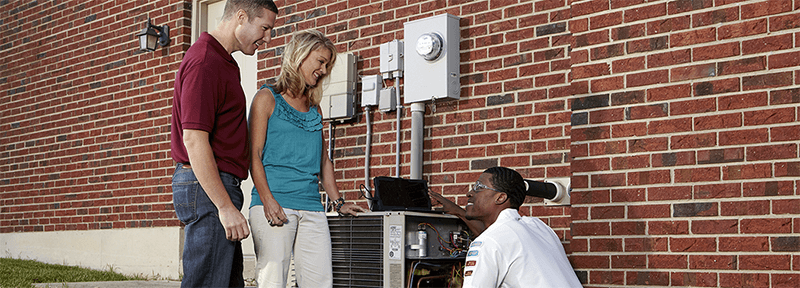
Steps You Can Take to Prepare your AC for Summer
Winter can be tough on outdoor equipment. When the weather warms up, there are a few steps you can take to prepare your air conditioner for the summer. With a little effort, you can set up your home for a trouble-free cooling season.
First, start with the outdoor unit:
- Remove any condenser covers, coil blankets or lids from the outdoor unit.
- Inspect outdoor unit panels.
- Remove debris from the outdoor coil.
- Repair or replace any damaged pipe insulation.
Then, inspect the indoor unit:
- Change the air filters.
- Check the indoor condensate drain lines.
- Clean the supply vents and return grills.
- Make sure your system is working properly on startup and throughout the first day (and turn it off immediately if it is not working!)
Here are some more tips to help you start up your air conditioner successfully:
Turn on the circuit breaker…carefully
Many homeowners turn off the circuit breaker for the outdoor unit during the winter. In the spring, it’s a good idea to carefully turn the circuit breaker back on at least 24 hours before powering up the air conditioning unit.
To turn on the indoor circuit breaker, first, find the breaker panel in your home. It may be in the basement or the garage. Carefully open the panel and find the breaker switch labeled outdoor AC. Flip the breaker switch to the on position. Don’t use any tools, and never stand in water when turning breakers on and off.
Many outdoor units also have a second electrical disconnect mounted outside in a rainproof box near the unit. This service disconnect is installed so that service personnel can easily remove the fuses from the outdoor unit during service. Homeowners generally don’t have to access this electrical box.
Adjust your humidifier, turning it all the way down.
Many homes with central air conditioning have a furnace-mounted humidifier for the entire home. These units maintain power humidity levels in your home during the cold winter months. Before starting up your air conditioner in the spring, it’s a good idea to turn the humidistat all the way down or off. This dial is usually mounted on or near the furnace. Be sure to turn off the water supply line if a water valve is available, and slide the air bypass door to the ‘summer’ position.
If the humidifier has a pad or screen to hold the water during evaporation, check for mineral deposits. This is the best time to clean or replace this function, if necessary. If dust or dry deposits have collected inside the humidifier, these should be vacuumed out as well. Check the furnace room periodically throughout the summer to ensure that no water is collecting on the floor.
Wait until it gets warm to start up your air conditioner.
Wait for a warm day to start up your air conditioner. If possible, stand by the unit while someone else turns the thermostat to cooling. Listen to the operation of the compressor and outdoor fan. After initial start-up sounds, the unit should be humming after about 30 seconds. Make sure the outdoor fan running quickly. The unit should not start and stop erratically. Hot air should be blowing out of the top of the outdoor condensing unit, and cold air should be blowing inside the house.
Make sure the system is set to run for at least 15 minutes the first time you turn it on.
Inspect the refrigerant lines.
There are two refrigerant lines running from the outdoor unit to the indoor air handler. The suction line is the large copper pipe on the outdoor unit. This line brings the cool refrigerant back to the compressor in the outdoor unit. The suction line should be insulated. Touch the suction line (or suction fitting) after about a minute to make sure it’s cold.
If you face any issues, turn the unit off immediately.
If the air doesn’t feel cool, or there’s no air at all, something is wrong. You should immediately turn off the system at the thermostat. We would recommend going through the checklist one more time. If the problem persists, turn the system off, and call a trusted HVAC contractor to diagnose the problem. Leaving the system turned on when it’s not running properly can do a lot of damage. Finding an HVAC professional to help figure out why your system isn’t working is always the best idea.
A brief inspection of your air conditioner now could help keep your system running smoothly during the summer months. When performing this inspection, take note of the overall system health in order to assess the likelihood of a problem. If your system is old and has endured an unusually harsh season, it might be time to call for help.
A qualified technician can help you do a more thorough spring technical inspection to avoid a system failure in the hottest months of the year. The technician can also help address any concerns you have, so let the contractor know what you found during your own inspection. Summer is just around the corner and no one knows your house better than you.



